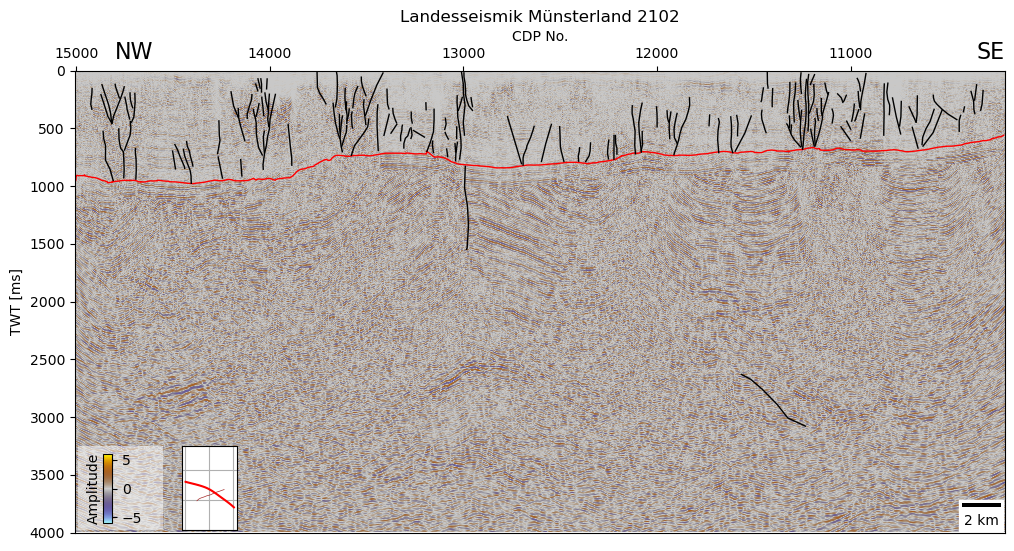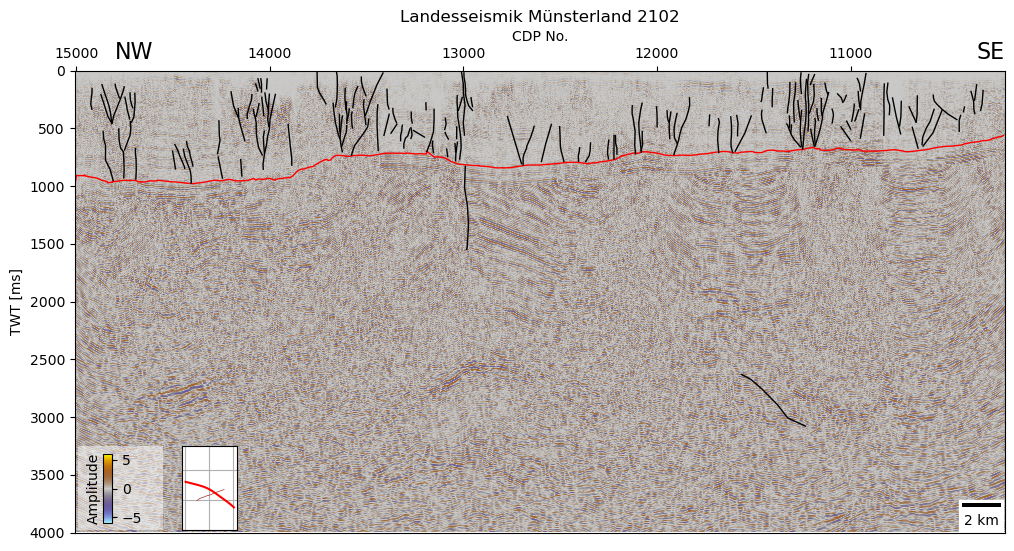65 Displaying Seismic Horizons and Faults
Contents
65 Displaying Seismic Horizons and Faults#
This notebook illustrates how to display seismic interpretations created in Petrel and exported as Shape Files in Python. The seismic data was acquired in 2021 and was obtained from the Geological Survey of NRW.

Set File Paths and download Tutorial Data#
If you downloaded the latest GemGIS version from the Github repository, append the path so that the package can be imported successfully. Otherwise, it is recommended to install GemGIS via pip install gemgis and import GemGIS using import gemgis as gg. In addition, the file path to the folder where the data is being stored is set. The tutorial data is downloaded using Pooch (https://www.fatiando.org/pooch/latest/index.html) and stored in the specified folder. Use
pip install pooch if Pooch is not installed on your system yet.
[1]:
import warnings
warnings.filterwarnings("ignore")
import gemgis as gg
import pandas as pd
import geopandas as gpd
import numpy as np
import matplotlib.pyplot as plt
import shapely
from typing import Union
from segysak.segy import segy_loader
[2]:
file_path ='data/65_displaying_seismic_horizons_and_faults/'
gg.download_gemgis_data.download_tutorial_data(filename="65_displaying_seismic_horizons_and_faults.zip", dirpath=file_path)
Opening traces of seismic lines#
For this tutorial, data of the Landesseismik Münsterland (see https://www.gd.nrw.de/zip/gd_report_2301s.pdf as reference) is used.
[3]:
seismic = gpd.read_file(file_path + 'Seismic_Lines_EPSG25832.shp')
seismic
[3]:
| Profile | length | geometry | |
|---|---|---|---|
| 0 | GD_NRW_2101 | 25436.00 | LINESTRING (389796.000 5749009.000, 389810.000... |
| 1 | GD_NRW_2102 | 48120.00 | LINESTRING (379724.000 5765301.500, 379734.000... |
Plotting the traces#
[4]:
figseismic, ax = plt.subplots(1, figsize=(10,10))
seismic.plot(ax=ax)
plt.grid()

Loading the seismic data using segysak#
The seismic data is loaded using segysak (https://segysak.readthedocs.io/en/latest/).
[5]:
landesseismik2102 = segy_loader(file_path + 'Muenster_2D_PreSTM_Stack_2102_AGC.sgy', vert_domain="TWT")
landesseismik2102
Loading as 2D
[5]:
<xarray.Dataset>
Dimensions: (cdp: 4806, twt: 1751)
Coordinates:
* cdp (cdp) uint16 10203 10204 10205 10206 ... 15005 15006 15007 15008
* twt (twt) float64 0.0 4.0 8.0 12.0 ... 6.992e+03 6.996e+03 7e+03
cdp_x (cdp) float32 4.215e+05 4.215e+05 4.215e+05 ... 3.797e+05 3.797e+05
cdp_y (cdp) float32 5.743e+06 5.743e+06 5.743e+06 ... 5.765e+06 5.765e+06
Data variables:
data (cdp, twt) float32 0.03581 -0.02099 -0.0793 ... -0.01154 0.04135
Attributes: (12/13)
ns: None
sample_rate: 4.0
text: C 1 Client Geologischer Dienst NRW\nC 2 Contra...
measurement_system: m
d3_domain: None
epsg: None
... ...
corner_points_xy: None
source_file: Muenster_2D_PreSTM_Stack_2102_AGC.sgy
srd: None
datatype: None
percentiles: [-3.0195783868438255, -2.780390889497134, -1.2279652...
coord_scalar: -100.0Converting seismic data to DataFrame#
The seismic data can also be converted to a DataFrame to better inspect the data.
[6]:
landesseismik2102.to_dataframe()
[6]:
| data | cdp_x | cdp_y | ||
|---|---|---|---|---|
| cdp | twt | |||
| 10203 | 0.00 | 0.04 | 421512.00 | 5743166.00 |
| 4.00 | -0.02 | 421512.00 | 5743166.00 | |
| 8.00 | -0.08 | 421512.00 | 5743166.00 | |
| 12.00 | -0.12 | 421512.00 | 5743166.00 | |
| 16.00 | -0.12 | 421512.00 | 5743166.00 | |
| ... | ... | ... | ... | ... |
| 15008 | 6984.00 | -0.11 | 379724.00 | 5765301.50 |
| 6988.00 | -0.03 | 379724.00 | 5765301.50 | |
| 6992.00 | -0.03 | 379724.00 | 5765301.50 | |
| 6996.00 | -0.01 | 379724.00 | 5765301.50 | |
| 7000.00 | 0.04 | 379724.00 | 5765301.50 |
8415306 rows × 3 columns
Getting the seismic colorbar#
We can load a color bar for displaying the seismic data. The colorbars were uploaded to the following repository: https://github.com/lperozzi/Seismic_colormaps
[7]:
cmap_seismic = gg.visualization.get_seismic_cmap()
type(cmap_seismic)
[7]:
matplotlib.colors.ListedColormap

Plotting the seismic data#
The seismic data is plotted the built-in plotting function
[8]:
fig, ax = plt.subplots(ncols=1, figsize=(15, 8))
landesseismik2102.data.transpose().plot(cmap=cmap_seismic)
plt.gca().invert_yaxis()

Converting seismic to array#
The loaded seismic data is converted into a NumPy array.
[10]:
landesseismik2102_array = gg.visualization.seismic_to_array(seismic_data=landesseismik2102, max_depth=4000)
landesseismik2102_array
[10]:
array([[ 0.03581395, -0.02099377, -0.07930481, ..., -0.3949225 ,
-0.64953464, -0.88681436],
[ 0.03755527, -0.02159597, -0.08407128, ..., -0.43278015,
-0.706827 , -0.9397521 ],
[ 0.04379281, -0.01925519, -0.09289104, ..., -0.45442533,
-0.7610789 , -1.0000496 ],
...,
[-0.19376808, -0.18929183, -0.09974575, ..., -1.1590624 ,
-0.46177298, 0.48989367],
[-0.16737616, -0.15299934, -0.07530349, ..., -1.0952702 ,
-0.30956793, 0.64396167],
[-0.15387064, -0.13157344, -0.06080835, ..., -1.0007935 ,
-0.14463931, 0.77823424]], dtype=float32)
The same dataset can be obtained using the built-in xarray attributes and methods.
[11]:
landesseismik2102.data.transpose()
[11]:
<xarray.DataArray 'data' (twt: 1751, cdp: 4806)>
array([[ 0.03581395, 0.03755527, 0.04379281, ..., -0.19376808,
-0.16737616, -0.15387064],
[-0.02099377, -0.02159597, -0.01925519, ..., -0.18929183,
-0.15299934, -0.13157344],
[-0.07930481, -0.08407128, -0.09289104, ..., -0.09974575,
-0.07530349, -0.06080835],
...,
[ 0.02854965, 0.03610878, 0.03544764, ..., -0.03994363,
-0.0334743 , -0.02788334],
[-0.3293916 , -0.32478482, -0.32344526, ..., -0.02570425,
-0.01836406, -0.01154189],
[-0.3131938 , -0.3141619 , -0.31639624, ..., 0.03036585,
0.0359443 , 0.04135381]], dtype=float32)
Coordinates:
* cdp (cdp) uint16 10203 10204 10205 10206 ... 15005 15006 15007 15008
* twt (twt) float64 0.0 4.0 8.0 12.0 ... 6.992e+03 6.996e+03 7e+03
cdp_x (cdp) float32 4.215e+05 4.215e+05 4.215e+05 ... 3.797e+05 3.797e+05
cdp_y (cdp) float32 5.743e+06 5.743e+06 5.743e+06 ... 5.765e+06 5.765e+06Loading Base Cretaceous Horizon - Landesseismik 2102#
The Base Cretaceous Horizon that was interpreted in Petrel is loaded as Shape File.
[12]:
base_cretaceous_2102 = gpd.read_file(file_path + 'U1_2102.shp')
base_cretaceous_2102 = gg.vector.extract_xyz(base_cretaceous_2102)
base_cretaceous_2102['Name'] = '2102'
base_cretaceous_2102['Z'] = base_cretaceous_2102['Z']*(-1)-150
base_cretaceous_2102.head()
[12]:
| Type | Domain | Droid | Comment | ShapeName | Project | geometry | X | Y | Z | Name | |
|---|---|---|---|---|---|---|---|---|---|---|---|
| 0 | Seismic horizon | Unknown | ://1d9a2dd1-dd1d-4676-a92e-6057e64d33c2/cb463e... | NaN | Base Cretaceous | C:\Users\Nicklas.Ackermann\Desktop\Muensterlan... | POINT Z (421497.819 5743179.962 -708.911) | 421497.82 | 5743179.96 | 558.91 | 2102 |
| 1 | Seismic horizon | Unknown | ://1d9a2dd1-dd1d-4676-a92e-6057e64d33c2/cb463e... | NaN | Base Cretaceous | C:\Users\Nicklas.Ackermann\Desktop\Muensterlan... | POINT Z (421490.638 5743186.924 -708.911) | 421490.64 | 5743186.92 | 558.91 | 2102 |
| 2 | Seismic horizon | Unknown | ://1d9a2dd1-dd1d-4676-a92e-6057e64d33c2/cb463e... | NaN | Base Cretaceous | C:\Users\Nicklas.Ackermann\Desktop\Muensterlan... | POINT Z (421483.457 5743193.886 -710.030) | 421483.46 | 5743193.89 | 560.03 | 2102 |
| 3 | Seismic horizon | Unknown | ://1d9a2dd1-dd1d-4676-a92e-6057e64d33c2/cb463e... | NaN | Base Cretaceous | C:\Users\Nicklas.Ackermann\Desktop\Muensterlan... | POINT Z (421476.276 5743200.848 -711.149) | 421476.28 | 5743200.85 | 561.15 | 2102 |
| 4 | Seismic horizon | Unknown | ://1d9a2dd1-dd1d-4676-a92e-6057e64d33c2/cb463e... | NaN | Base Cretaceous | C:\Users\Nicklas.Ackermann\Desktop\Muensterlan... | POINT Z (421469.095 5743207.810 -711.894) | 421469.10 | 5743207.81 | 561.89 | 2102 |
[13]:
fig, ax = plt.subplots(1, figsize=(10,10))
base_cretaceous_2102.plot(ax=ax)
plt.grid()

Calculating Position on Seismic Line Base Cretaceous#
The x, y, z positions are converted to positions along the seismic line.
[14]:
line = seismic.loc[1].geometry
line
[14]:
[15]:
base_cretaceous_2102_features = gpd.read_file(file_path + 'Seismic_Horizons_CDPs_Lines_Base_Cretaceous.shp')
base_cretaceous_2102_features
[15]:
| Name | geometry | |
|---|---|---|
| 0 | 2102 | LINESTRING (10204.968 558.911, 10205.975 558.9... |
[16]:
fig, ax = plt.subplots(1, figsize=(10,10))
base_cretaceous_2102_features.plot(ax=ax)
plt.grid()

[18]:
base_cretaceous_2102_features_linestrings, change_points = gg.visualization.split_seismic_horizons(features_gdf=base_cretaceous_2102_features,
threshold=20)
base_cretaceous_2102_features_linestrings, change_points
[18]:
( geometry id
0 LINESTRING (10204.968 558.911, 10205.975 558.9... 0
1 LINESTRING (13187.289 701.514, 13188.379 698.4... 1
2 LINESTRING (13191.373 723.164, 13192.368 723.1... 2
3 LINESTRING (15002.008 950.317, 15003.002 950.094) 3,
[0, 2947, 2951, 4761, 4763])
[19]:
base_cretaceous_2102_features_points = gg.vector.extract_xy(base_cretaceous_2102_features)
base_cretaceous_2102_features_points['distance'] = base_cretaceous_2102_features_points.distance(base_cretaceous_2102_features_points.shift(), align=True)
base_cretaceous_2102_features_points
[19]:
| Name | geometry | X | Y | distance | |
|---|---|---|---|---|---|
| 0 | 2102 | POINT (10204.968 558.911) | 10204.97 | 558.91 | NaN |
| 1 | 2102 | POINT (10205.975 558.911) | 10205.97 | 558.91 | 1.01 |
| 2 | 2102 | POINT (10206.981 560.030) | 10206.98 | 560.03 | 1.50 |
| 3 | 2102 | POINT (10207.985 561.149) | 10207.98 | 561.15 | 1.50 |
| 4 | 2102 | POINT (10208.985 561.894) | 10208.99 | 561.89 | 1.25 |
| ... | ... | ... | ... | ... | ... |
| 4759 | 2102 | POINT (15000.002 909.671) | 15000.00 | 909.67 | 0.99 |
| 4760 | 2102 | POINT (15000.980 909.075) | 15000.98 | 909.07 | 1.15 |
| 4761 | 2102 | POINT (15002.008 950.317) | 15002.01 | 950.32 | 41.26 |
| 4762 | 2102 | POINT (15003.002 950.094) | 15003.00 | 950.09 | 1.02 |
| 4763 | 2102 | POINT (15004.007 949.935) | 15004.01 | 949.93 | 1.02 |
4764 rows × 5 columns
[20]:
threshold = 20
[21]:
fig, ax = plt.subplots(1, figsize=(10,10))
base_cretaceous_2102_features_linestrings.plot(ax=ax, column='id', cmap='Paired')
base_cretaceous_2102_features_points[base_cretaceous_2102_features_points['distance']>=threshold].plot(ax=ax, color='red')
plt.grid()

[22]:
base_cretaceous_2102_features_linestrings.to_file(file_path + 'Seismic_Horizons_CDPs_Lines_Base_Cretaceous_split.shp')
[23]:
faults = gpd.read_file(file_path + 'Faults_CDPs_Lines_split.shp')
faults
[23]:
| Name | geometry | |
|---|---|---|
| 0 | Fault interpretation 164 | LINESTRING (10410.600 309.512, 10417.264 362.367) |
| 1 | Fault interpretation 165 | LINESTRING (10348.015 117.902, 10359.164 262.483) |
| 2 | Fault interpretation 166 | LINESTRING (10825.354 111.007, 10827.121 201.4... |
| 3 | Fault interpretation 167 | LINESTRING (10806.579 103.932, 10812.443 187.4... |
| 4 | Fault interpretation 168 | LINESTRING (10919.610 20.529, 10929.574 120.41... |
| ... | ... | ... |
| 140 | Fault interpretation 52 | LINESTRING (10378.146 176.226, 10363.864 266.9... |
| 141 | Fault interpretation 53 | LINESTRING (10438.399 532.834, 10438.399 430.5... |
| 142 | Fault interpretation 56 | LINESTRING (10661.375 452.519, 10656.012 384.4... |
| 143 | Fault interpretation 57 | LINESTRING (10783.751 231.979, 10763.524 400.9... |
| 144 | Fault interpretation 58 | LINESTRING (10737.597 262.077, 10739.699 399.9... |
145 rows × 2 columns
Plotting the seismic data and interpretations using matplotlib#
[24]:
minx = landesseismik2102.to_dataframe().reset_index()['cdp'].min()
maxx = landesseismik2102.to_dataframe().reset_index()['cdp'].max()
minx, maxx
[24]:
(10203, 15008)
[25]:
from matplotlib_scalebar.scalebar import ScaleBar
fig, ax = plt.subplots(1, figsize=(12,6))
im = ax.imshow(np.fliplr(landesseismik2102_array.T),
cmap=cmap_seismic,
vmin=-6,
vmax=6,
extent=[maxx,
minx,
4000,
0])
ax.xaxis.set_ticks_position('top')
ax.xaxis.set_label_position('top')
axins = ax.inset_axes(bounds=[0.03, 0.02, 0.01, 0.15])
axseismic = ax.inset_axes(bounds=[0.06, 0.006, 0.17, 0.181])
seismic.plot(ax=axseismic, color='brown', linewidth=0.5)
seismic[1:2].plot(ax=axseismic, color='red', linewidth=1.5)
axseismic.set_ylim(5.725e6, 5.795e6)
axseismic.grid(visible=True, which='both',axis='both')
axseismic.set_yticklabels([])
axseismic.set_xticklabels([])
axseismic.xaxis.set_ticks_position('none')
axseismic.yaxis.set_ticks_position('none')
cbar = fig.colorbar(im, cax=axins)
cbar.set_label('Amplitude' ,labelpad=-40)
ax.set_ylabel('TWT [ms]')
ax.set_xlabel('CDP No.')
ax.set_title('Landesseismik Münsterland 2102')
ax.text(10350, -100, 'SE', fontsize=16)
ax.text(14800, -100, 'NW', fontsize=16)
pp1 = plt.Rectangle((14550, 3250), 440, 725, zorder=1, facecolor='white', alpha=0.5)
ax.add_patch(pp1)
scalebar = ScaleBar(0.01, "km", length_fraction=0.1, location='lower right')
ax.add_artist(scalebar)
base_cretaceous_2102_features.plot(ax=ax, color='red', linewidth=1, marker='-')
faults.plot(ax=ax, color='black', linewidth=1, marker='-')
plt.ylim(4000,0)
plt.gca().set_aspect('auto')

